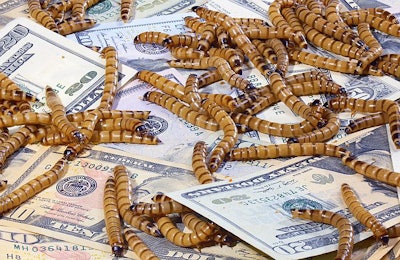
Food and agriculture investment group AgFunder ranked a novel pet food ingredient producer among those insect farms that secured significant funding in the past year.
“There’s a funding race occurring in the insect farming space…,” wrote Agfunder’s market analysts.
Agfunder’s analysts released their observations in the report “Agrifood Tech Funding Report: Year Review 2018.” Their business statistics derived from data on 29,939 companies.
Record funding for pet food ingredient insect farm
During the past 12 months, two companies broke the record for largest amount of funding raised by an insect farm, according to AgFunder.
First, in June 2018, Agriprotein raised US$105 million to set a record for largest arthropod agriculture funding deal of all time. Agriprotein operates in the United Kingdom and South Africa. The company produces black soldier fly larvae for livestock feed.
Agriprotein’s record didn’t stand for long, as France-based Ÿnsect announced on Feb. 21 that it had raised US$125 million in funding during a series C round, which is a session meant for scaling up a business. The funds will help the company build a facility in Amiens Metropole, France while expanding internationally. Ÿnsect intends to increase their presence in the North American market as well.
Ÿnsect produces protein and oil from mealworms and fertilizer from their waste. The company was founded in 2011.
Two other insect farms, InnovaFeed and Entomo Farm, also made it into AgFunder’s top 20 novel agricultural systems business deals category. InnovaFeed pulled in US$18 million in funding. Entomo Farm received US$3.5 million. Entomo Farms uses crickets to make products for pets, humans and livestock.
The InnovaFeed deal ranked as the second largest seed funding deal of 2018.
“Insect farming is a capital intensive, real asset based business so it’s unsurprising to see France’s InnovaFeed at the top of the list,” wrote AgFunder analysts.
Nascent insect-based pet food industry eyes ecology
Ecologists suggested that insect farms focus on developing ideal sustainability practices before the insect-based pet food ingredient industry grows too large to change easily, reported Petfood Industry. Meanwhile, arthropod agriculturalists aim to achieve just that at Ϋnsect’s fully automated pilot plant in France, where the company produces protein and oil from mealworms (Tenebrio molitor).
“Why not do it great from the beginning?” Åsa Berggren, ecology professor at the Swedish University of Agricultural Sciences, said. “Think about sustainability now, since it’s easier than once they [insect farms] are already built.”
Berggren and her colleagues wrote a paper noting areas where the nascent insect farming industry needs more research to establish best practices for sustainability. Trends in Ecology and Evolution published the paper.
Native insects as pet food protein sources
For one thing, insect farms should be wary of potential environmental effects of escapees, she said. Errant insects could become invasive species.
Using native insect species would be a safer choice for agricultural operations than raising species that could escape and compete with indigenous insects, she said.
For example, insect-based protein and oil producer Ϋnsect raises yellow mealworms. These arthropods are native to France and many other regions where they have been reared for decades as fish bait, Constant Motte, business development manager for Ynsect, said.
In the case of the mealworms, the age of the insects limits their chances for escape.
“We raise them in confined buildings and our insects, mainly at the larvae phase, cannot escape from their trays,” he said. “It is a fantastic insect that likes to be raised in a high density, social environment and at the larvae phase it cannot fly or jump because it has no wings or legs. The risk of escape from this closed building is insignificant.”
Energy used in insect farming operations
The resources used to produce protein from animals affect both the environment and the economy. Insects may provide a solution to this dilemma, because of their potentially much lower resource needs than mammals and poultry.
“There have been some studies done, and insects are lots better than cows and pigs,” Berggren said.
Ϋnsect raises mealworms on safe, controlled, vegetable byproducts that are not intended primarily for human food, said Motte.
Likewise, when processing those mealworms into protein and oil, Ϋnsect endeavors to use as little energy as possible.
“An important benefit of our technology is that there is no waste,” he said. “The whole larva is used.”
Even the insects’ excrement, called frass, can be used.
Renewable energy and fertilizer from insect protein production
Insect frass can be fermented into methane biogas, Motte said.
“The other option is to use frass as a great organic fertilizer to bring back organic matter into the soil. We can then store carbon and create a stable humus needed for the fertility of agriculture soils.
Considering these and other ecologically positive potentials of insect farming, Berggren said she doesn’t want to swat the industry. Instead, she calls for further research to make sure the burgeoning bug business gets started on the right foot, or six feet in this case.



















